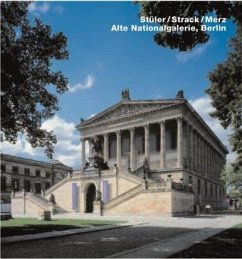When Wilhelm I gave the go-ahead for the building of the Alte Nationalgalerie in 1861, this at last provided an opportunity to develop the Museum Island, which at the time consisted only of Karl Friedrich Schinkel's Altes Museum and Friedrich August Stüler's Neues Museum, in the form once dreamed of by Friedrich Wilhelm IV. The Romantic on the Prussian throne had intended to transform the Spree island beyond Schinkel's muse-um into a "haven of art" and prepared some designs for it himself. Here we also find a building in the form of a temple on a high plinth for the first time. Stüler was commissioned to design the new building, but he died unexpectedly in 1865, even before work had started. His successor was Johann Heinrich Strack, who completed the building and its artistic furnishings by 1876.
But this was not the end of the building history of the Alte Nationalgalerie, which became a national monument because of its triumphal lines. Museum directors like Ludwi g Justi and Eberhard Hanfstaengl, new ideas about museums, urgently needed space, war damage and rebuilding in the days of the GDR changed the interior of the building fundamentally. It has now been completely refurbished on the occasion of the 125th anniversary of the museum's opening. HG Merz of Stuttgart was entrusted with this commission through his wealth of experience as a museum architect. His concept was to reveal the various historical strata of the building, without turning it into a museum piece itself. The principal protagonist in the Alte Nationalgalerie is 19th-century art, not 21st-century architecture and service equipment. Careful restoration brought the orig-inal decoration of Strack's building to light in some places, and also the small Jugendstil galleries dating from the changes made under the direction of Justi. This has produced a museum that does not deny its origins, but they are not thrust into the foreground either.
Klaus Jan Philipp is profes sor of architectural history at the Hochschule für bildende Künste in Hamburg. Edition Axel Menges has published his "Um 1800 - Architekturtheorie und Architekturkritik in Deutschland zwischen 1790 und 1810" and Karl Friedrich Schinkel. Späte Projekte / Late Projects. Christian Gahl took a photography course and then studied architecture. He has worked in Berlin as an architectural photographer since 1996.
But this was not the end of the building history of the Alte Nationalgalerie, which became a national monument because of its triumphal lines. Museum directors like Ludwi g Justi and Eberhard Hanfstaengl, new ideas about museums, urgently needed space, war damage and rebuilding in the days of the GDR changed the interior of the building fundamentally. It has now been completely refurbished on the occasion of the 125th anniversary of the museum's opening. HG Merz of Stuttgart was entrusted with this commission through his wealth of experience as a museum architect. His concept was to reveal the various historical strata of the building, without turning it into a museum piece itself. The principal protagonist in the Alte Nationalgalerie is 19th-century art, not 21st-century architecture and service equipment. Careful restoration brought the orig-inal decoration of Strack's building to light in some places, and also the small Jugendstil galleries dating from the changes made under the direction of Justi. This has produced a museum that does not deny its origins, but they are not thrust into the foreground either.
Klaus Jan Philipp is profes sor of architectural history at the Hochschule für bildende Künste in Hamburg. Edition Axel Menges has published his "Um 1800 - Architekturtheorie und Architekturkritik in Deutschland zwischen 1790 und 1810" and Karl Friedrich Schinkel. Späte Projekte / Late Projects. Christian Gahl took a photography course and then studied architecture. He has worked in Berlin as an architectural photographer since 1996.

